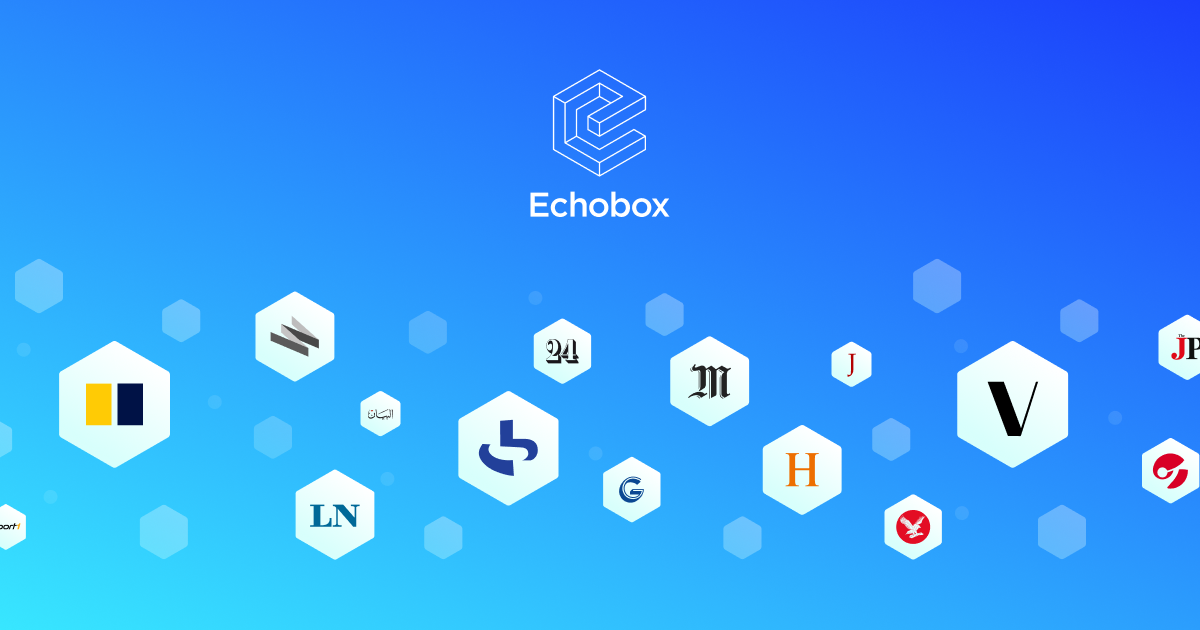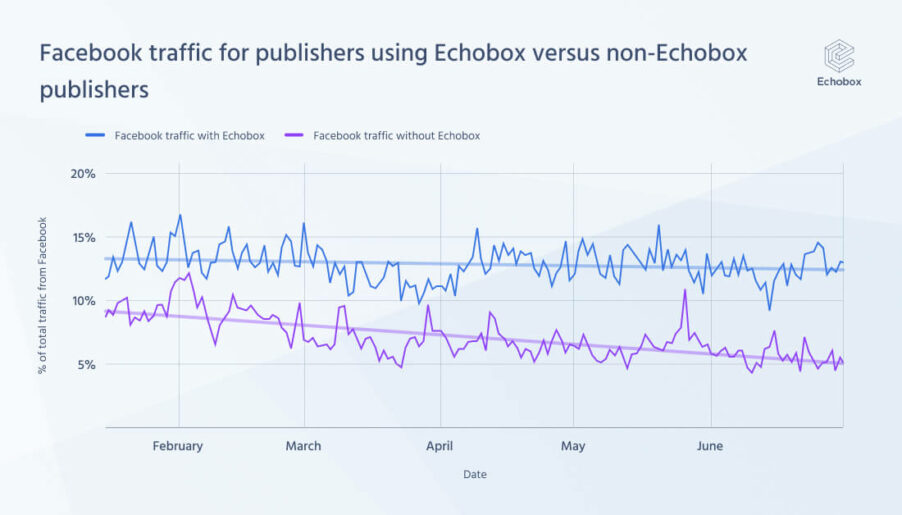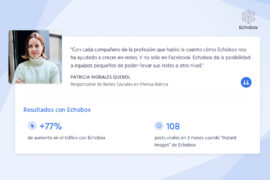Update, December 11th 2024: In the last month or so, publishers have seen a return to falling Facebook traffic, impressions and engagement across the industry. The Social Media Index shows that traffic from the platform has routinely dropped below 4% of all referrals through November and into December. This, our data indicates, is due to another change in Facebook’s algorithms. We also found that Echobox users continue to perform better than non-Echobox users. Nevertheless we’re monitoring the situation closely as well as working on ways to combat this trend.
Falling Facebook traffic has been a major issue for news publishers during the past year or so. But not all news publishers have been affected equally. Publishers using Echobox have found this drop in referral traffic to be significantly smaller than those not using Echobox. Why is this the case?
How did we get here?
Publishers have seen their advertising income disappear into the hands of a few big companies. Figures for 2022 showed the global ad market exceeding $500 billion, with Google and Meta accounting for almost 50% of all revenues.
To counter this dominance, the idea of forcing large tech companies to pay for news content on their platforms has gained traction with lawmakers around the world. Facebook experimented with its News Tab, which paid publishers for links, while revenue-sharing deals have been struck in Australia and the EU, and legislation based on the Australian model has been passed in Canada. In countries such as India and Indonesia, calls to implement similar policies are growing as concerns about the viability of local and national news ecosystems mount.
Historically, attempts to pass revenue-sharing legislation have been met with stern resistance from the companies who would be affected. In the Australian case, Meta temporarily removed all news links from its services to force the government into a compromise. The same game of brinkmanship is underway in Canada.
Rather than be forced to reach collective bargaining agreements in multiple nations, Meta has opted to deprioritize news altogether. In doing so it headed off the threat of being forced to comply with new legislation around the world.

How bad has this decline in Facebook traffic been?
With the decision to deprioritize news content, Facebook traffic has declined. In June of this year, Gizmodo published an article based on Echobox data that showed traffic for some publishers declining precipitously. That piece quoted an anonymous employee at a publication who will speak for many in the industry. “Our content,” he said “has provided a lot of value to Facebook, we’ve been a part of the ecosystem since they launched Facebook Pages over a decade ago. But as a small business, it seems like Facebook doesn’t respect us.”
Our analysis shows that publishers who aren’t using intelligent AI to share on Facebook have seen steep declines in traffic. 
Even with a spike towards the end of May, traffic has been declining month on month. Indeed, in a six-month period from the beginning of January to the end of June, the percentage of total traffic that publishers receive from Facebook has dropped from an average of 9.3% to 5.6% — a drop of 40%.
Has this decline in Facebook traffic been as bad for publishers using Echobox?
Falling Facebook traffic is a systemic issue, caused by fundamental changes to the platform. That said, the scale of the decline has not been uniform across the board. Publishers using Echobox’s AI have been far less affected, comparatively, than their non-Echobox using peers.
We analyzed the decline in Facebook traffic for publishers using two of Echobox’s main features:
Timing optimization: Timing optimization makes sure that your best content is being shared at the best time for your audience, increasing reach and engagement. Echobox uses historical data as well as your real-time audience data to reverse engineer the Facebook algorithm. This allows the AI to adapt your posting strategy to any changes.
Autofeed: The Autofeed uses AI technology to automate your social posting on Facebook, Instagram, TikTok, Twitter and LinkedIn. Along with Echobox optimizations, it ensures the best possible performance by increasing the accuracy with which your content is shared.
| Did you know: The Echobox Web Tag is a new code snippet available to all Echobox users. It’s quick and easy to install and keeps you fully GDPR compliant. But it also increases performance. By improving the granularity and accuracy of the data that gets fed into your Echobox, Echobox users who have also installed the Web Tag have seen significant gains across social platforms. You can read more here. |
With AI-powered optimizations in place, publishers using Echobox show far greater resilience to Facebook’s deprioritization of news content.

In contrast to the steep decline seen by non-Echobox users, Facebook traffic for Echobox users remains relatively stable. Over the same six-month period that saw a 40% decrease in referral traffic from Facebook for non-Echobox users, those publishers using Echobox experienced a fall in Facebook traffic of 9.3% — from an average of 13.7% in January to 12.4% in June.
How can you protect against a loss of Facebook traffic?
Using Echobox’s AI can help to mitigate some of the most severe effects of Facebook’s algorithm changes. But it can help you do much more. Any publisher’s best defense against falling Facebook traffic is two-fold: use AI to squeeze the best performance possible from your content; and diversify how you share that content.
Echobox Social can help you efficiently manage your social presence. Not just on Facebook, but on Twitter, Instagram, TikTok and LinkedIn, as well. By increasing the number and variety of people you can reach publishers reduce dependence on Facebook.
Echobox Email, meanwhile, puts our cutting-edge AI to work with your newsletters — an area of increasing focus for many publishers. Changes at Facebook demonstrate the extent to which publishers are at the mercy of social media companies. For this reason, email newsletters have never been a more viable option for publishers to build a dedicated, paying audience.
Using your RSS feeds, Echobox automatically creates and sends emails, ensuring the right send time and content for each reader. Cutting-edge AI and data analysis help to increase open and click rates, and convert more subscribers into paying customers.
However Facebook’s war with news publishers ends, having the most diverse channels for sharing your content is important. It reduces reliance on any single traffic source, as well as extending your reach to a broader demographic. And Echobox is there to help.




